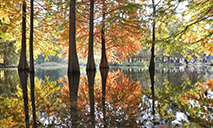Mudanjiang: stockpile of geologic wonders and nature’s bounty

Aerial photo taken on Oct. 23, 2021 shows the composite volcanoes in the Jingpohu Global Geopark in Mudanjiang, northeast China’s Heilongjiang Province. (Photo/ Han Xu)
Mudanjiang shares the name with the river that runs through it. Nestled in China’s chilliest, northernmost Heilongjiang province, this city on the China-Russian border has blended the bounty of treasures bequeathed to it into something luxuriant and enthralling. Snow aside, Mudanjiang has more to deliver: a wonderfully preserved natural landscape, a panoply of tourism and cultural resources, and promising and interesting business opportunities.
In late autumn, the peak of the colorful fall season has just come to an end. The yellows of Dahurian larches and reds of maple trees turn tawny and brown, with only the pine and spruce trees holding onto their green needles. Yet the fading fall foliage also subtly lays bare the city’s geologic beauty, something that the heat-escaping locals in summer and snow-lovers in winter might probably overlook.

Aerial photo shows the composite volcanoes in the Jingpohu Global Geopark in Mudanjiang City, northeast China’s Heilongjiang Province. (Photo/Provided to People’s Daily Online)
Ancient landscape of pure waters and pristine forests
As the Mudan River sluices northward to Jingpo Lake, its route has traversed the landscape of northeast China for at least ten thousand years. The lake, located in the Jingpohu UNESCO Global Geopark, is the largest alpine lava barrier lake in China and was shaped during ancient volcanic eruptions after blocking the river flow to form an enticing dream world along its banks.
On top of the magnificent Cenozoic volcanic landforms, thousands of years of primary succession silently evolved as species of plants and trees overtook these dormant volcanoes. The dozen volcanic craters in the geopark are home to lush primitive forests, which have gradually evolved from the pioneering expansion of lichens, mosses, blooming and fruiting shrubs to temperate forests with red pine, amur lime, and needle fir.

A photo shows the Diaoshuilou waterfall in the Jingpohu Global Geopark in Mudanjiang City, northeast China’s Heilongjiang Province. (Photo/Provided to People’s Daily Online)
“The well-preserved and high-quality ecosystem of the Jingpo Lake scenic area has irreplaceable significance compared with other geoparks in China. It also holds much allure for geologists and explorers, a real treasure for academic research,” said Zhao Huying, manager of the Jingpohu Tourism Group.
Precisely because of its geologic conditions and the loamy layer of earth on top, the landscape provides a valuable habitat for a stunning mixture of fauna and flora. The forests are home to numerous protected animals, including sables, black bears, and Siberian roe deers. After a provincial ban on logging and efforts in afforestation and the clearing of illegal hunting traps, the number of wild animals surrounding the city has undergone a steady increase. In recent years, more and more wild Siberian tigers were spotted by camera traps, which also signifies the recent ecological improvements here. One of the most representative plants, Xiangshui rice, is the only rice variety in the world that can grow in the earthen soil of basalt rocks. High in amino acids, vitamins, and minerals, the rice enjoys a nationwide reputation and is often served at state banquets.
There is even more to explore along the riverbanks—which served as the prehistoric residential sites for the Sushen people, the ancient ancestors of Manchurians. Some of the items that were also discovered in the Neolithic ruins included implements made from stone, horn-like arrows, a deer-horn hoe, and clay figurines modeled in the shape of a pig, which proves that the Sushen had already entered into a hoe-farming stage of development and had achieved primitive techniques in stock farming.

A photo taken on October 23, 2021, shows fishermen fishing at the Jingpo Lake in Mudanjiang City, northeast China’s Heilongjiang Province. (Photo/Han Xu)
Over the past 3,000 years, the descendants of the Sushen all left behind splendid cultural traditions during a variety of different dynasties. To this day, fishermen at Jingpo Lake still honor some of their ancestors’ traditional Manchurian rituals. During winter fishing activities, for example, fishermen will honor the god of the lake to ‘awake’ their fishing nets while letting go of the first fish caught on the first cast, hoping for luck and a good harvest.

A photo shows fruiting wood ear emerging out of sawdust bags in the county-level city of Dongning in Mudanjiang, northeast China’s Heilongjiang Province. (Photo/Provided to People’s Daily Online)
Nature’s black gift to Mudanjiang
Aware of the potential presented by this land of abundance, the Mudanjiang people have found their own path towards development. Amidst the miscellany of lifeforms here, the chocolatey black wood ear mushroom is at the forefront of changes afoot at the county-level city of Dongning in southeast Mudanjiang.
Wood ear is the first edible fungus to ever be cultivated by humans. In Dongning, the long history of cultivating wood ear can be traced back to the Tang Dynasty (618-907). Traditional cultivation methods have involved wild foraging and the planting of wood ear on felled trees and wooden logs. However, after combining these techniques with innovations in planting technologies, fungus cultures, and growing equipment, wood ear is now able to be widely and sustainably cultivated using sawdust.
“The world’s best wood ear is in China, and China’s best wood ear is in Dongning,” this slang expression often being proudly repeated by the locals living in the county-level city. The locality’s high rate of forest coverage, favorable humidity range, and large diurnal swings provide just about the perfect conditions for growing the fungus.
The wood ear’s shape is similar to that of a crescent moon, and sports a crunchy texture and a smooth, velvety mouthfeel. Compared with the wood ear in other parts of China, it contains more nutrients. It is also known for its curative powers, said Li Guiqing from the wood ear industry office in Suiyang, Dongning.

An employee is harvesting wood ear in the county-level city of Dongning in Mudanjiang, Heilongjiang Province. (Photo/Provided to People’s Daily Online)
Around this time of year, harvested wood ears are being dried and bagged, waiting to be sold at the Yurun Suiyang wood ear market, the largest wood ear distributing center in China. “This platform attracts businessmen from all over China. It is really a boost to the local economy and has changed people’s lifestyles,” Li Guiqing said.
That can be palpably seen from the lives of the frequenters setting up shop there: namely, the wood ear dealers. Li Shuying, a dealer from Sichuan doing business in Guangdong province, has been coming to this market every year during the past three decades, with her son being in charge of sales to customers further downstream back in Guangdong. She has been in Dongning for three months this time around, patiently selecting harvested wood ear of the best quality for her customers.
“Many traveling merchants come here several times a year. Some even bring their families and rent a house here during the harvest season,” Li said. At this market, her life epitomizes that of the thousands of dealers who have made a fortune from the fungus business.
Meanwhile, as more and more dealers conduct business through e-commerce channels, a large volume of harvested wood ear is also being traded in the virtual world of the Internet and even exported abroad to countries like South Korea and Russia.

A photo shows fruiting wood ear mushrooms emerging out of sawdust bags in the county-level city of Dongning in Mudanjiang, northeast China’s Heilongjiang Province. (Photo/Provided to People’s Daily Online)
At present, the market’s annual trading volume can reach over 100,000 tons, with the annual turnover meanwhile surpassing 6 billion RMB; that is two-thirds of China’s total wood ear trading volume, rightfully earning Dongning a reputation as the ‘capital’ of the wood ear industry.
The wood ear industry has already become the city’s pillar industry. In 2020, the production value of the wood ear industry in Dongning reached over 2 billion RMB, resulting in an incremental increase in annual per capita incomes after rising by 15,200 RMB. This year’s statistics show that 22 percent of local farmers now engage in wood ear production.
In recent years, the black fungus has also shown increasing business potential as it becomes adopted as one of the ingredients used in snacks, drinks, cosmetics, and a variety of other products. Here in Dongning, the wood ear mushroom industry is mushrooming, budding forth in full force.
Photos
Related Stories
Copyright © 2021 People's Daily Online. All Rights Reserved.










